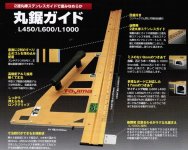I know there's another similar thread currently, but I'm looking to specially compare corded models and the TS55/MFT combo vs the spring loaded rails.
Ok, so I've been using the TS55 a lot for the past couple months. I've been considering getting an MFT, pretty much just for crosscutting and squaring up. I find the saw very awkward for both operations. I think this is in part because of the fact that I work on saw horses and in part because of the horrible clear splitter guard (I've ordered black splinter guard, but I'm waiting for the clear one to get worn out). I find the ts 55 especially awkward for crosscutting real lumber, like a deck board.
So my thought is that the HK 55 may do everything that the TS/MFT combo does (so far as cutting operations) but is more portable. Not sure if this is accurate, since I've never used an MFT or HK.
Seems like the main issues are:
1. Dust collection is worse on the HK. I don't mind saw dust, but everyone in my area is in looooove with Hardie siding. Is the dust collection from the HK good enough to use with Hardie or mirtec without getting a nosebleed?
I'm getting ready to do a big Hardie job and am rigging up a cut table for the TS55 just so I can have the dust collection.
2. The plunge hinge works the opposite way. I'm not really sure what this effects. Might be nice that it plunges like a regular skilsaw?
3. Won't bevel cut a 2x. I guess neither will, and I'm not sure that I need it. I've seen guys on here say this say is for framing (I wouldn't use it for framing), seems like a siding/decking/trim saw. I think the hk will fit a 6-1/2 blade?
I think the cost of setting up the HK and selling the TS would be about the same as getting an MFT. So the question is, does the HK do everything the TS does, plus the ability to use the spring loaded rails?
Ok, so I've been using the TS55 a lot for the past couple months. I've been considering getting an MFT, pretty much just for crosscutting and squaring up. I find the saw very awkward for both operations. I think this is in part because of the fact that I work on saw horses and in part because of the horrible clear splitter guard (I've ordered black splinter guard, but I'm waiting for the clear one to get worn out). I find the ts 55 especially awkward for crosscutting real lumber, like a deck board.
So my thought is that the HK 55 may do everything that the TS/MFT combo does (so far as cutting operations) but is more portable. Not sure if this is accurate, since I've never used an MFT or HK.
Seems like the main issues are:
1. Dust collection is worse on the HK. I don't mind saw dust, but everyone in my area is in looooove with Hardie siding. Is the dust collection from the HK good enough to use with Hardie or mirtec without getting a nosebleed?
I'm getting ready to do a big Hardie job and am rigging up a cut table for the TS55 just so I can have the dust collection.
2. The plunge hinge works the opposite way. I'm not really sure what this effects. Might be nice that it plunges like a regular skilsaw?
3. Won't bevel cut a 2x. I guess neither will, and I'm not sure that I need it. I've seen guys on here say this say is for framing (I wouldn't use it for framing), seems like a siding/decking/trim saw. I think the hk will fit a 6-1/2 blade?
I think the cost of setting up the HK and selling the TS would be about the same as getting an MFT. So the question is, does the HK do everything the TS does, plus the ability to use the spring loaded rails?

